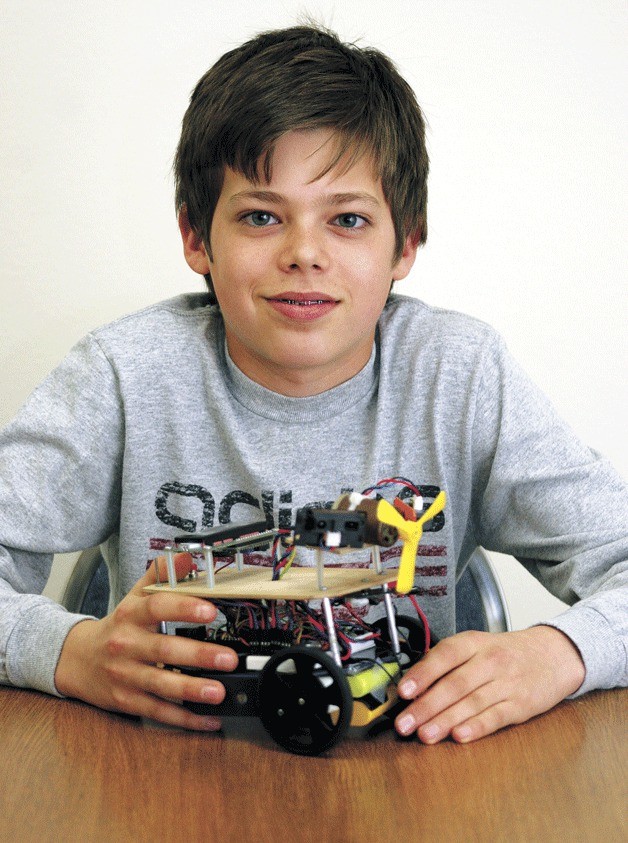When it comes down to the old question of which came first, the chicken or the egg, for Daniel Nathan, the answer comes easy.
The robot came first.
Daniel, 13, recently returned as a first-place winner in the Trinity College Firefighting Robot Contest.
The competition, held in Hartford, Conn., drew more than 130 teams from across the country, as well as China, Taiwan, Indonesia, India and Israel.
Daniel, however, was the solo individual competitor. With his home-built robot called Flame-B-Gone, he successfully sent his high-tech gizmo through a maze where it completed its mission by blowing out a candle.
Daniel, an eighth-grader at Hyla Middle School, said he built his first robot when he was 7 or 8.
His interest in remote-controlled planes and cars eclipsed his robot-building projects for a few years, he admitted, until he was reading Robot Magazine one day and saw a story about the Hartford competition.
Enter the egg.
“When I got this robot, I was like OK, what am I going to do with it? What is going to be its challenge?” Daniel recalled.
“And then I thought back on the competition and I thought, ‘Hey, I’m going to make a firefighting robot.”
Bit by bit, the robot came together as pieces arrived in the mail; motors, an arduino (open-source single-board microcontroller), sensors for measuring distance and heat, rubberized wheels.
More and more decks were added as pieces were fit into place for the robot.
“Some more elegantly than others,” Daniel said, eyeing his robot.
“I personally think the LCD [liquid crystal display] is the most elegantly mounted. It looks nice. It looks so crisp and clean.
“Unlike my beautiful wiring,” he said sarcastically.
Daniel also had to create the software side of the robot, and wrote about 600 lines of computer code to get it to work. That meant figuring out how to make it navigate a maze, find a candle in the maze, and then extinguish the flame.
Then came the competition, and though Daniel had practiced running his robot through a home-built maze made of tri-fold display boards back on Bainbridge Island, he’d never put the robot through a full maze until he got to the competition.
Arriving at the competition, and seeing dozens of other teams put their robots quickly through their paces, was a real eye-opener.
The Chinese team had brought multiple robots, which were “ridiculously fast,” he said.
It was apparent that the other robot-builders had faced the same technical problems that Daniel had experienced and overcome.
Daniel’s reaction: “Whoa, you’ve really got that thing down. It works every time.”
When Daniel put his robot through the maze, there was a bit of drama. The Flame-B-Gone made its way along the walls of the maze, but when it got to the room with the candle, it looked like the robot had rolled slightly off-kilter and stopped without directly facing the flame.
Daniel gasped, but the tiny fan on the top of the robot fluttered to life, and poof! Out went the flame. It had taken the Flame-B-Gone 23 seconds to make its way through maze.
Still, the speedy firefighting robots from China’s teams took the two top spots in the juniors division. The team from Talcott Mountain Science Center in Connecticut placed third, and Daniel and his Flame-B-Gone, fourth.
Daniel, however, won first place in the Olympiad Exam, a test on robot-related math and physics questions.
He’s already thinking of his next robot, he said. He’ll use the lessons learned from building Flame-B-Gone for a more elaborate robot, something bigger, with wheels in the middle of the robot, and one that will use carbon dioxide to extinguish the flame.
Beyond building robots, Daniel’s other interests include wilderness survival, sports such as Ultimate Frisbee and soccer, rock climbing and reading.
Elana Riffle, his science teacher at Hyla Middle School, said Daniel’s excitement is contagious, and his sense of humor, infectious.
“Daniel synthesizes information extremely quickly. His curiosity is just palpable,” Riffle said. “His enthusiasm just stretches out to all the other kids.”
Riffle recalls how Daniel, as part of their clean-up crew at the school, will raise random topics and give mini five-minute “Daniel lectures” to those within earshot.
“He will pick a topic and just talk about it, which is just hilarious,” she said.
One recent topic: Why Bill Gates has lots of money.
“Daniel really just makes me happy to be teacher,” she added.
Daniel doesn’t come from a family of robot builders. His father, Adam Nathan, works in IT, and his mother, Melanie Nathan, is a nurse.
When asked what the ultimate robot he wanted to build would look like, Daniel said he had a pretty good idea. It would be relatively large, have tracks instead of wheels, and have an arm that could pick up things, sort them, and place them into built-in trays. It would also have to have GPS, he said.
“Basically, ridiculous and unaffordable to me,” he said.



